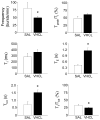Chronic serotonin-norepinephrine reuptake transporter inhibition modifies basal respiratory output in adult mouse in vitro and in vivo
- PMID: 22871263
- PMCID: PMC3463639
- DOI: 10.1016/j.resp.2012.07.004
Chronic serotonin-norepinephrine reuptake transporter inhibition modifies basal respiratory output in adult mouse in vitro and in vivo
Abstract
Respiratory disturbances are a common feature of panic disorder and present as breathing irregularity, hyperventilation, and increased sensitivity to carbon dioxide. Common therapeutic interventions, such as tricyclic (TCA) and selective serotonin reuptake inhibitor (SSRI) antidepressants, have been shown to ameliorate not only the psychological components of panic disorder but also the respiratory disturbances. These drugs are also prescribed for generalized anxiety and depressive disorders, neither of which are characterized by respiratory disturbances, and previous studies have demonstrated that TCAs and SSRIs exert effects on basal respiratory activity in animal models without panic disorder symptoms. Whether serotonin-norepinephrine reuptake inhibitors (SNRIs) have similar effects on respiratory activity remains to be determined. Therefore, the current study was designed to investigate the effects of chronic administration of the SNRI antidepressant venlafaxine (VHCL) on basal respiratory output. For these experiments, we recorded phrenic nerve discharge in an in vitro arterially-perfused adult mouse preparation and diaphragm electromyogram (EMG) activity in an in vivo urethane-anesthetized adult mouse preparation. We found that following 28-d VHCL administration, basal respiratory burst frequency was markedly reduced due to an increase in expiratory duration (T(E)), and the inspiratory duty cycle (T(I)/T(tot)) was significantly shortened. In addition, post-inspiratory and spurious expiratory discharges were seen in vitro. Based on our observations, we suggest that drugs capable of simultaneously blocking both 5-HT and NE reuptake transporters have the potential to influence the respiratory control network in patients using SNRI therapy.
Copyright © 2012 Elsevier B.V. All rights reserved.
Figures




Similar articles
-
Comparison of the effects of serotonin selective, norepinephrine selective, and dual serotonin and norepinephrine reuptake inhibitors on lower urinary tract function in cats.Life Sci. 2002 Aug 2;71(11):1227-36. doi: 10.1016/s0024-3205(02)01848-9. Life Sci. 2002. PMID: 12106588
-
Induction of hyperlocomotion in mice exposed to a novel environment by inhibition of serotonin reuptake. A pharmacological characterization of diverse classes of antidepressant agents.Pharmacol Biochem Behav. 2002 Apr;71(4):667-80. doi: 10.1016/s0091-3057(01)00701-8. Pharmacol Biochem Behav. 2002. PMID: 11888558
-
A multinational pharmacoeconomic evaluation of acute major depressive disorder (MDD): a comparison of cost-effectiveness between venlafaxine, SSRIs and TCAs.Value Health. 2001 Jan-Feb;4(1):16-31. doi: 10.1046/j.1524-4733.2001.004001016.x. Value Health. 2001. PMID: 11704969
-
[Serotonin-noradrenaline reuptake inhibitors(SNRIs)].Nihon Rinsho. 2001 Aug;59(8):1523-9. Nihon Rinsho. 2001. PMID: 11519152 Review. Japanese.
-
SNRIs: their pharmacology, clinical efficacy, and tolerability in comparison with other classes of antidepressants.CNS Spectr. 2005 Sep;10(9):732-47. doi: 10.1017/s1092852900019726. CNS Spectr. 2005. PMID: 16142213 Review.
Cited by
-
Heart Rate Variability Changes in Patients With Major Depressive Disorder: Related to Confounding Factors, Not to Symptom Severity?Front Neurosci. 2021 Jul 5;15:675624. doi: 10.3389/fnins.2021.675624. eCollection 2021. Front Neurosci. 2021. PMID: 34326716 Free PMC article.
-
Desmetramadol Has the Safety and Analgesic Profile of Tramadol Without Its Metabolic Liabilities: Consecutive Randomized, Double-Blind, Placebo- and Active Comparator-Controlled Trials.J Pain. 2019 Oct;20(10):1218-1235. doi: 10.1016/j.jpain.2019.04.005. Epub 2019 Apr 18. J Pain. 2019. PMID: 31005596 Free PMC article. Clinical Trial.
References
-
- Al-Zubaidy ZA, Erickson RL, Greer JJ. Serotonergic and noradrenergic effects on respiratory neural discharge in the medullary slice preparation of neonatal rats. Pflügers Arch. 1996;431:942–949. - PubMed
-
- Anderson IM. Selective serotonin reuptake inhibitors versus tricyclic antidepressants: a meta-analysis of efficacy and tolerability. J Affect Disord. 2000;58:19–36. - PubMed
-
- Annerbrink K, Olsson M, Hedner J, Eriksson E. Acute and chronic treatment with serotonin reuptake inhibitors exert opposite effects on respiration in rats: possible implications for panic disorder. J Psychopharmacol. 2010;24:1793–1801. - PubMed
-
- Béïque J, de Montigny C, Blier P, Debonnel G. Effects of sustained administration of the serotonin and norepinephrine reuptake inhibitor venlafaxine: I. In vivo electrophysiological studies in the rat. Neuropharmacol. 2000a;39:1800–1812. - PubMed
-
- Béïque J, de Montigny C, Blier P, Debonnel G. Effects of sustained administration of the serotonin and norepinephrine reuptake inhibitor venlafaxine: II. In vitro studies in the rat. Neuropharmacol. 2000b;39:1813–1822. - PubMed
Publication types
MeSH terms
Substances
Grants and funding
LinkOut - more resources
Full Text Sources

